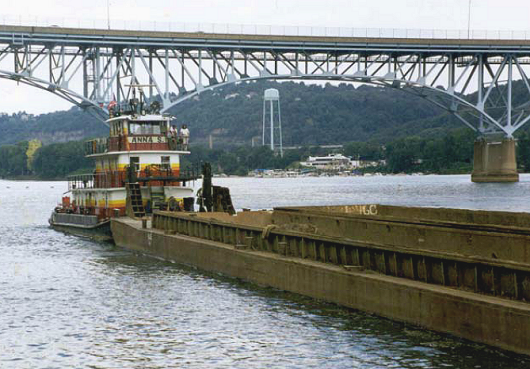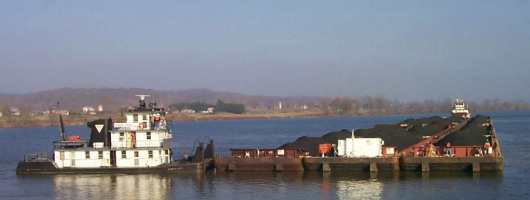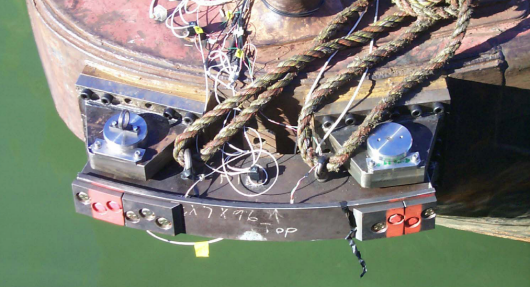A barge flotilla (alternatively called a ‘barge tow’) is a collection of individual barges (typically carrying bulk cargo) that are connected together with wire rope lashings (cables) so that the entire unit can be economically moved by a single push boat. Along inland waterways, navigational structures play a vital role in guiding and controlling barge traffic. Concrete guard walls and guide walls are typically used to protect dams (and nearby hydroelectric facilities) from intrusion and damage from barge traffic, and to help guide barge flotillas into lock chambers. At the terminal ends of concrete guide walls are relatively stiff reinforced concrete structures known as bullnoses. Both walls and bullnoses may be subjected to service level impact loads that arise when barge flotillas execute controlled alignment maneuvers prior to entering a lock. However, in some circumstances, these structures can also be subjected to extreme-event impacts from out-of-control (errant) barge flotillas. This latter type of event can lead to substantial impact loads and potentially cause severe structural damage.
Our research group, working jointly with the U.S. Army Corps of Engineers (USACE), has engaged in a multi-phase study to investigate barge flotilla impacts on waterway structures of varying types with the primary goals of quantifying dynamic impact loads and developing load prediction methodologies for use in structural design. State-of-the-art high resolution finite element models of multiple-barge flotillas have been developed and used to investigate glancing (oblique angle) impacts against wall structures, and head-on impacts on bullnose structures. Wall structures investigated to date include ‘rigid’ concrete guide walls; semi-rigid (post-tensioned, segmental) concrete guide walls; pile-founded concrete guide walls; and flexible timber & composite (FRP) guide walls. Selected experimental data collected from full-scale USACE barge impact tests of rigid and semi-rigid concrete walls have been used to validate our high-resolution barge finite element models. Subsequently, impact loads computed from wide ranging parametric finite element impact simulation studies of both walls and bullnoses have been used to develop empirical load prediction models and simplified (low-order) dynamic load prediction models.
Research Reports
2016
Determination of Barge Impact Loads for Probabilistic Design of Miter Gates [ Report release date: TBD ]
Used as hydraulic control structures, double-leaf steel miter gates are present at a significant number of the navigational lock sites maintained by the United States Army Corps of Engineers. When a barge flotilla moves into a lock chamber, the potential exists for low speed impacts against the closed miter gates. In this study, advanced nonlinear dynamic finite element impact simulation techniques were used to quantify barge flotilla impact loads on horizontally-framed miter gates, and thus facilitate the development of simplified, empirical load prediction equations for use in miter gate design.
Development of Low-Order Dynamic Code Module For Impact Load Prediction [ Report release date: TBD ]
Impact forces generated during oblique barge impacts on wall structures are functions of wall stiffness, wall mass, nonlinear corner-crushing stiffness of the impacting barge, and the overall stiffness characteristics (flexure, shear) of the multi-barge flotilla. In this study, simplified dynamic equations of motion for multi-row barge flotillas were derived and used to develop an efficient low-order nonlinear dynamic analysis algorithm. Results from the low-order dynamic analysis algorithm compared favorably to those from high-resolution analyses over a range of different structural types.
2014
Determination of Barge Flotilla Impact Loads on Pile Founded Concrete Guide Walls & Development of a Unified Impact Load Prediction Model for Navigational Structures [ PDF file ]
Finite element models of massive concrete guide walls supported on timber piles were developed and used, in conjunction with multi-barge flotilla models, to simulate oblique impact conditions and to quantify impact loads. Data from wide-ranging impact simulation studies of walls and bullnose structures were collected together and used to develop empirical load prediction equations and simplified (low-order) dynamic load prediction models.
2013
Determination of Multi-Barge Flotilla Impact Loads on Bullnose Structures and Flexible Timber Guide Walls [ PDF file ]
Finite element models were developed of bullnose structures and flexible timber guide wall structures. Head-on impacts of multiple-barge flotillas striking bullnose structures of varying geometric configurations were simulated to quantify impact loads. Similarly, shallow-angle oblique impacts on the flexible timber guide wall structure were simulated to quantify impact loads.
2012
Development of Multi-Barge Flotilla Finite Element Models for use in Probabilistic Barge Impact Analysis of Flexible Walls [ PDF file ]
A finite element model of a post-tensioned, segmental, semi-rigid concrete guide wall was developed and integrated with multi-barge flotilla models. Various shallow angle barge impact scenarios with semi-rigid walls were simulated, and forces predicted by simulations were compared to full-scale experimental test data.
Development of Finite Element Models for Studying Multi-Barge Flotilla Impacts [ PDF file ]
Finite element models of multi-barge flotillas were developed, including detailed representations of barge contact interactions and wire-rope (lashing) cables. Various impact scenarios with rigid walls were simulated, and forces predicted by simulations were compared to full-scale experimental test data as well as forces computed using existing design guidelines.
Hurricane Protection Structures
Research Reports
2010
Development and Support of Dynamic Numerical Modeling of Aberrant Rake Barges Impacting Hurricane Protection Structures Subjected to Forces from a Hurricane Environment [ PDF file ]
Dynamic barge impact forces on hurricane protection walls and dolphin structures were quantified for a large number of impact scenarios. Discussions were provided regarding finite element model details for the various model components, and the sensitivity of simulation results to choices made regarding the model parameters. Guidance was provided for employing impact force results in static design scenarios.
U.S. Army Corps Of Engineers Internal Research Projects
Research Reports
2011
Dynamic Structural Flexible-Beam Response to a Moving Barge Train Impact Force Time- History Using Impact Beam [ PDF file ]
2003
Full-Scale Barge Impact Experiments, Robert C. Byrd Lock and Dam, Gallipolis Ferry, West Virginia [ PDF file ]
Analysis of Impact Loads from Full-Scale, Low-Velocity, Controlled Barge Impact Experiments, December 1998 [ PDF file ]
Prototype Barge Impact Experiments, Allegheny Lock and Dam 2, Pittsburgh, Pennsylvania [ PDF file ]
2000
Probabilistic Barge Impact Analysis of the Upper Guide and Guard Walls at Marmet Locks and Dam [ PDF file ]














